Effects of Obstacles
Rivers are filled with various obstacles. Many obstacles like holes, waves, and falls make the very rapids we find challenging and fun. Other obstacles like low head dams, sieves, undercuts, and strainers are features we really want to avoid. Scouting, either from the boat or on shore is one of the most important precautions we can take to avoid becoming another statistic.
A major part of this course is devoted to teaching you about various river obstacles you are likely to encounter and how to recognize them. Various articles in this section provide pictures of the above features. Take time to look at them closely so you can recognize them yourself. Ask yourself, why a certain feature might or might not be dangerous. We will also show you a number of features; some dangerous, some not on the second day of our course. Learn how to spot potential trouble from the shore as well as from your boat. As you get more experience, you will find it easier to recognize hazards and exactly how water interacts with them.
Bends
 When current flows around a bend in a river, it flows much faster and deeper on the outside of the bend. The velocity and depth on the inside of a river bend is much slower and shallower. You can use this to your advantage by sneaking on the inside and eventually moving more towards the center when you feel comfortable. It is usually a good idea to point your boat on an angle away from the outside wall. This enables you to quickly paddle away from the wall if you get too close. Some bends have reactionary waves against the wall that can be fun to ride. Take a close look at the picture on the right which is Upset Rapid on the Grand Canyon. Notice the strong wave train close to the wall.
When current flows around a bend in a river, it flows much faster and deeper on the outside of the bend. The velocity and depth on the inside of a river bend is much slower and shallower. You can use this to your advantage by sneaking on the inside and eventually moving more towards the center when you feel comfortable. It is usually a good idea to point your boat on an angle away from the outside wall. This enables you to quickly paddle away from the wall if you get too close. Some bends have reactionary waves against the wall that can be fun to ride. Take a close look at the picture on the right which is Upset Rapid on the Grand Canyon. Notice the strong wave train close to the wall.
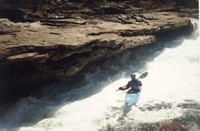 Since river bends tend to undercut the river bank they are crashing against,
Since river bends tend to undercut the river bank they are crashing against,
it pays to stay off the wall just in case. Here is a great example where the river
has undercut the wall. Imagine if the water were higher and the undercut were
hidden.
Eddies / Eddy Lines
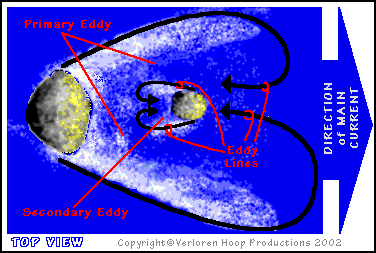 Eddies are your friend! All good boaters catch eddies and use them to control their descent downstream. A good rule of thumb in paddling is to never leave an eddy until the coast is clear from above and you can see how to reach an eddy below. Eddies are formed by blockages in the river. A blockage can be a rock, penninsula, ledge, or even a man-made object. Water flows downstream around the object creating a depression in the surface of the water. Water directly behind the object is either still or moving slowly back upstream to fill in the small depression. When the water makes it back up the the object, it bounces off to the sides and flows back downstream. The calm water is what we call the eddy. The area between the downstream and upstream water flow is called the eddy line or fence. The top of the eddy line closest to the obstruction is very well defined. As you follow the eddy line downstream away from the boulder the dividing line is less well defined. When catching eddies, it is important to catch the eddy high, right below the rock where it is strongest and the eddy fence is the most narrow.
Eddies are your friend! All good boaters catch eddies and use them to control their descent downstream. A good rule of thumb in paddling is to never leave an eddy until the coast is clear from above and you can see how to reach an eddy below. Eddies are formed by blockages in the river. A blockage can be a rock, penninsula, ledge, or even a man-made object. Water flows downstream around the object creating a depression in the surface of the water. Water directly behind the object is either still or moving slowly back upstream to fill in the small depression. When the water makes it back up the the object, it bounces off to the sides and flows back downstream. The calm water is what we call the eddy. The area between the downstream and upstream water flow is called the eddy line or fence. The top of the eddy line closest to the obstruction is very well defined. As you follow the eddy line downstream away from the boulder the dividing line is less well defined. When catching eddies, it is important to catch the eddy high, right below the rock where it is strongest and the eddy fence is the most narrow.
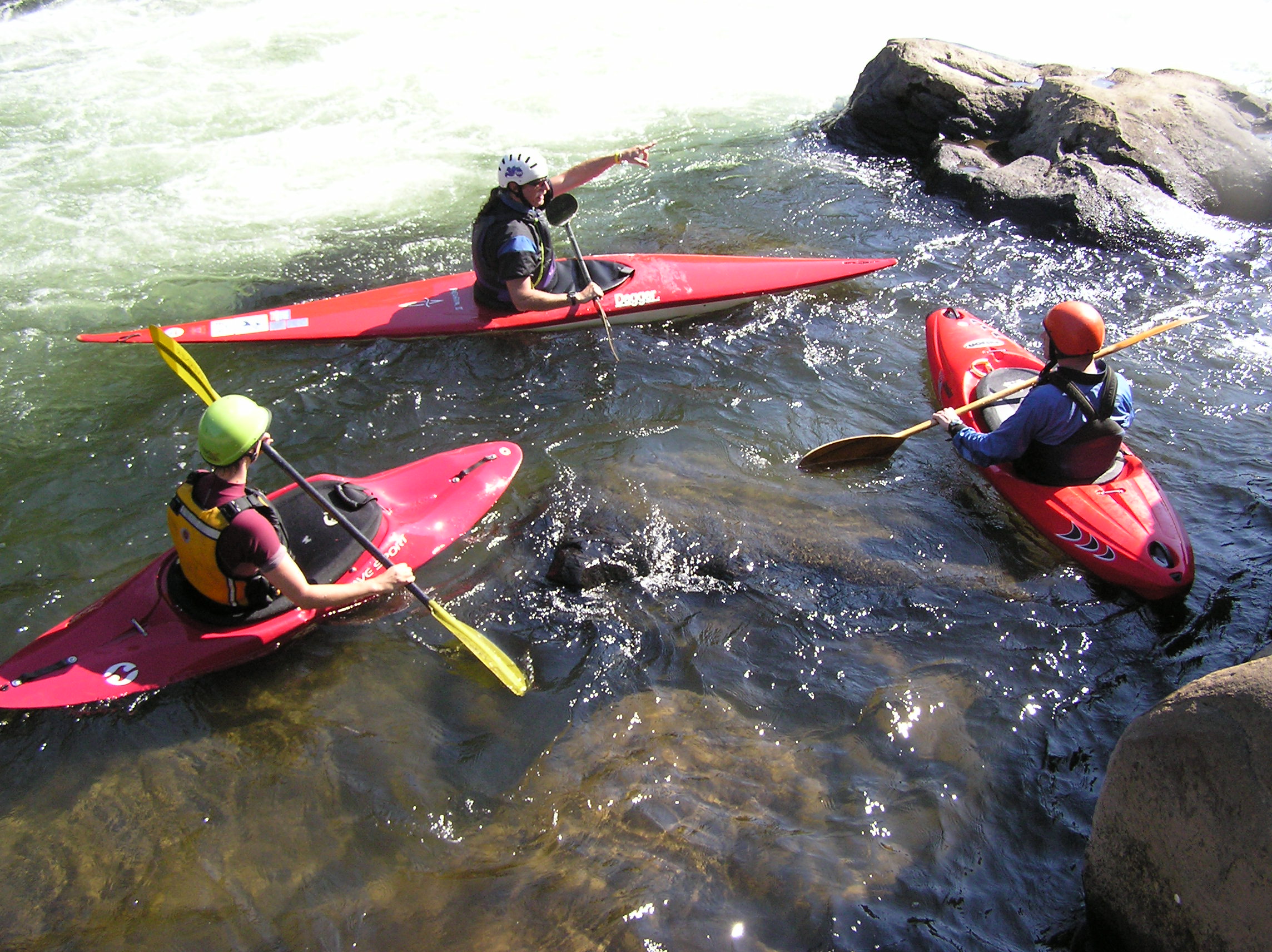 Here is a good example from the Lower Yough. Notice how relaxed we look. The slack water prevents us from drifting downstream. The eddy line is also very easy to see on our left side.
Here is a good example from the Lower Yough. Notice how relaxed we look. The slack water prevents us from drifting downstream. The eddy line is also very easy to see on our left side.
Downstream and Upstream V's / Chutes
Introduction
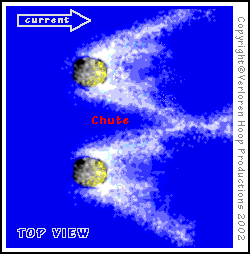 Rocks and boulders are the backbone in the formation of many rapids. When the current meeets up with boulders, it behaves differently depending on where it meets the obstruction. Current that hits the boulder head-on backs up and may form a pillow if the surface area is wide. If there is minimal surface area, water quickly escapes along the sides starting eddy lines on both sides of the boulder. The eddy lines diverge further away from each other as you continue downstream. Looking downstream at the water turbulence, it resembles a V pointing upstream. When current passes between two boulders, the eddy lines from each angle towards each other forming a V pointing downstream. The water is often smooth in the middle of this V and we call this a tongue. When the two eddy lines intersect, we often get tail waves. When you have some gradient between the two boulders, the passage way is called a chute. Most of the time, we try to aim for the middle of a chute and ride the smooth water tongue.
Rocks and boulders are the backbone in the formation of many rapids. When the current meeets up with boulders, it behaves differently depending on where it meets the obstruction. Current that hits the boulder head-on backs up and may form a pillow if the surface area is wide. If there is minimal surface area, water quickly escapes along the sides starting eddy lines on both sides of the boulder. The eddy lines diverge further away from each other as you continue downstream. Looking downstream at the water turbulence, it resembles a V pointing upstream. When current passes between two boulders, the eddy lines from each angle towards each other forming a V pointing downstream. The water is often smooth in the middle of this V and we call this a tongue. When the two eddy lines intersect, we often get tail waves. When you have some gradient between the two boulders, the passage way is called a chute. Most of the time, we try to aim for the middle of a chute and ride the smooth water tongue.
The Downstream V
 Rapids are formed by water running over and around rocks and ledges. The most basic feature is the downstream V that develops when water runs between two rocks. This feature is also known as a tongue. Generally, this is what you want to aim for.
Rapids are formed by water running over and around rocks and ledges. The most basic feature is the downstream V that develops when water runs between two rocks. This feature is also known as a tongue. Generally, this is what you want to aim for.
The Upstream V
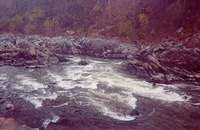 The opposite of this feature is an upstream V. In an upstream V, water rushes around a rock. In the previous picture, you can clearly see two upstream V's. In general, we try to avoid upstream V's or at least lean into the rock to avoid capsizing.
The opposite of this feature is an upstream V. In an upstream V, water rushes around a rock. In the previous picture, you can clearly see two upstream V's. In general, we try to avoid upstream V's or at least lean into the rock to avoid capsizing.
Chutes
 Chutes are formed when the river drops between two boulders. Chutes with large drops are called waterfalls or tall ledges. Drops can be more angled as well. Some drops are quite shallow and we call those slides.
Chutes are formed when the river drops between two boulders. Chutes with large drops are called waterfalls or tall ledges. Drops can be more angled as well. Some drops are quite shallow and we call those slides.
Page 3 of 6
